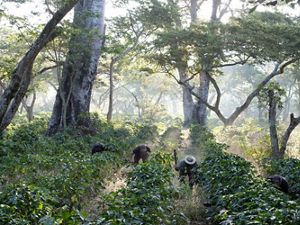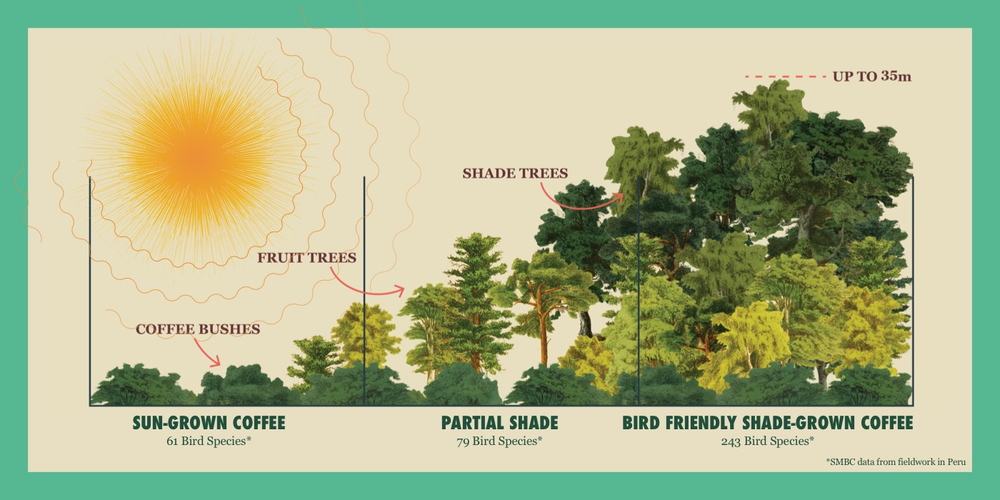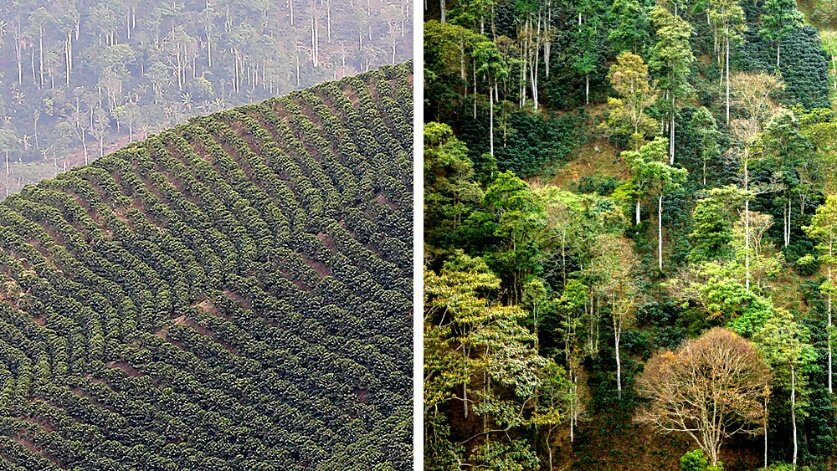
Arianna Ertl
Fall Semester Internship 2020
English Major at West Chester University minoring in Psychology and Italian.
Learn more about Arianna Ertl
November 22, 2020
Help the Rainforest with a Cup of Shade Grown Coffee
The climate crisis we are facing has created an urgent need for finding practical and useful ways to be environmentally conscious while still maintaining our lifestyle. Something as simple as your morning cup of coffee has a significant ability to make a change in the world by taking a bigger step towards sustainable agriculture. By enjoying a delicious cup of ACEER’s Rainforest Coffee you can help support female run businesses in Peru, provide habitat for songbirds, stop deforestation and reduce pollution.

This Rainforest blend is 100% Fair Trade Organic Peruvian, shade grown, and certified bird friendly. Shade grown coffee is recognized for its fair trading for farmers, providing organic benefits to people and the environment, and proving to be more sustainable than sun-grown coffee.
In their dedication to rainforest preservation, the ACEER Foundation has worked on their shade grown coffee partnership to help the environmental and economic struggles in Peru. Connected with their own coop of farmers called La Florida in Peru, they produce 100% organic shade grown coffee. ACEER has teamed up with House Cup Coffee in Havertown, PA to distribute their Rainforest Blend.
Not only does House Cup provide quality organic coffee, but they also take pride in each roast to bring out the intrinsic qualities of the coffee bean while providing fresh coffee on the go or to take home. For each bag purchased, one dollar of the proceeds goes to One Tree Planted to plant a tree in the Amazon Rainforest. In the past year, the Rainforest Blend has been able to provide 408 trees to One Tree Planted. The owner of House Cup Coffee Brian Niles believes it is his job to give back to the community. He believes we are “saving the Peruvian rainforest by drinking this coffee”.
For each bag purchased, one dollar of the proceeds goes to One Tree Planted to plant a tree in the Amazon Rainforest. In the past year, the Rainforest Blend has been able to provide 408 trees to One Tree Planted.
Not only does ACEER’s partnership with House Cup provide organic benefits to the local community, but they are also working to improve the livelihood of Peruvian farmers who dedicate their lives to producing environmentally conscience coffee for the world to enjoy. With an increase in demand and a decrease in agricultural sustainability, now more than ever it is essential to be concerned with how our coffee is produced.
Fair Trade Coffee
Coffee is one of the most popular beverages globally, with 7.5 million tons consumed each year. This is a number that is expected to increase to 16.5 million tons going to existing and new consumers in China and India within the next two decades (Killeen and Harper, 2016). Many people are unaware of the hardships of the people connected to the coffee industry, “The social footprint of coffee also includes the 25 million smallholders in developing countries who produce 80% of coffee globally, as well as the livelihoods of another 125 million people connected to the industry” (Fairtrade, 2012).
Faced with low prices and high labor costs, smallholders are challenged with financial issues, along with the decrease of sustainable land for coffee production. Due to a spike in climate change (such as increasing temperatures and changing precipitation patterns), the land used for coffee production is expected to decrease by 80% in countries such as Brazil, Nicaragua, and El Salvador (Killeen and Harper, 2016). To maintain the luxury of coffee production, we must learn to adapt its agriculture to match economic and environmental conditions.

Fair Trade in the coffee industry protects the economic and social justices of the farmers in developing countries. Shade grown coffee supports the farmers and the land in which “it’s likely to be Fair Trade as well. Over half of all organic coffee is Fair Trade certified” (Craves, 2006). Certified organic coffee is most successful when it is shade grown because sun-grown coffee requires chemicals such as fertilizer and pesticides. If it is shade grown, it is always certified organic. Eliminating these chemicals is better for the health of the farmers, especially the kids who are involved. The fair-trade benefits of shade grown coffee production has improved the lives of Peruvian farmers including the women. The producers of ACEER’s Rainforest Blend, La Florida is a co-op that has grown with their involvement with Café Femenino, a fair-trade coffee label that supports Peruvian female farmers. The women in Peru have proven to be responsible and sustainable with their income.
As the care takers of children and the elderly, Peruvian women use their income for improving local resources such as food, education, and medicine. They live to give back to their community and the land, something that has been supported through the shade grown coffee industry. Farmer Lili Leyva Alvites, featured on the left in the above photograph, explains her community’s relationship with fair-trading, “Café Femenino has empowered her and her female neighbors in La Florida, a small coffee-growing village in the lush eastern Andean foothills of northern Peru. By seeking out female farmers, the partnership has given those women freedom and power they have never experienced before” (Tegel, 2016).
By supporting indigenous farmers through shade grown coffee production, we are simultaneously taking care of the ecosystem of the Amazon rainforest.
It is quite remarkable how much fair-trade of organic and shade grown coffee agriculture has impacted La Florida farmers. This is a way of life people from all over the world can help give to Peruvian farmers and even influence this agricultural change globally, by switching to shade grown coffee. It is necessary to support the Indigenous communities in the Amazon, for they are the ones who protect and care for the land. By supporting indigenous farmers through shade grown coffee production, we are simultaneously taking care of the ecosystem of the Amazon rainforest. Shade grown farms coexist with the ecosystem because the trees sustain insect life attracting birds and provide a natural way to fertilize crops.
The impact of coffee farms on wildlife
The rise in deforestation has caused the rainforests to experience a significant decline in migratory songbird populations. Sun coffee plantations are very much responsible for a hit to the ecosystem, “As its name suggests, full-sun farming requires that producers deforest large plots of land for the sake of growing coffee plants and harvesting the crop at high yields” (Fu, 2019). This is causing the migrating birds to lose their homes and increase their chances of extinction. “Of the 6 million acres of coffee lands, 60% have been stripped of shade trees since 1972” (Rice, 2020). If we keep decimating the trees at this rate there will be nothing left for future generations and we will be responsible for the extinction of wildlife, something we cannot reverse. Not only do shade grown coffee farms provide a home for migratory birds, but they also supply food. The canopy of trees that cover the coffee provide a diverse ecosystem of insects, therefore the birds are a natural pest control.
Not only do shade grown coffee farms provide a home for migratory birds, but they also supply food. The canopy of trees that cover the coffee provide a diverse ecosystem of insects, therefore the birds are a natural pest control.
However, these insects and birds have their own preference of tree species. Professor Doug Tallamy of the University of Delaware conducted a study to determine which trees farmers should plant to better attract insects that have coevolved with the trees to attract migratory birds. In his study Tallamy discovered, “the very trees that are good for birds may be simultaneously beneficial for farmers. Tallamy’s study highlighted the appeal of nitrogen-fixing, leguminous species. These can absorb nitrogen in the air and transfer it to the soil, making it more fertile” (Fu, 2019).
The trees used in shade plantations also provide their own fruitful bearings, “Native plants that shade coffee trees which can range from forest trees like cedars, to fruit trees, like banana, orange, lemon, avocado, and soursop are planted to create a harmonious nitrogen balance in the soil, and, over time, effect a specific, coffee-beneficial microclimate” (Clayton, 2018).
It is a win-win using a canopy of trees in which we get healthier coffee and help support a variety of food for the people and animals of the Amazon to enjoy. Shade grown coffee farms are starting to become more elevated in which we are learning more about the biodiversity shade farms can provide to attract a variety of birds and other animals. The more we focus on shade grown techniques, the more we can assure they can be certified bird friendly as well.

Shade Grown Coffee helps reduce pollution
The Amazon Rainforest is home to indigenous communities who have found sustainable ways to maintain the agriculture that supplies millions of people with their daily coffee fix. They are a part of the rainforest and work daily to respect its natural habitat. They understand that the ecosystem is a home and if they do not preserve that home it will not support life.
The Amazon is the world’s largest rainforest ecosystem, it spans 9 countries and is home to almost 30% of plant and animal species on Earth (One Tree Planted, 2020). Preserving the land and wildlife is essential for our well-being and the production of coffee has shown to be a significant example of how we should and should not be farming. Shade grown coffee has proven to be eco-friendly providing natural fertilizers and reducing pollution.
Shade grown coffee requires little to no chemical fertilizers or pesticides; the symbiotic relationship between the birds and trees provides a natural maintenance.
Sun grown coffee requires more maintenance and stress on the plant from being in full sun exposure. Next to tobacco, coffee is sprayed with more chemicals than any other product consumed by humans (Earth Easy, 2020). Sun grown coffee is reliant on more chemicals for pest and disease control because it is grown as a monocrop lacking a diversity of trees for support. It is easy to forget that the chemicals do not just disappear, they become a part of the plant and land. These chemicals often wander into the soil and water resources; endangering the people and animals who rely on that land for food and water.
Shade grown coffee requires little to no chemical fertilizers or pesticides; the symbiotic relationship between the birds and trees provides a natural maintenance. The trees are also a natural protection from the weather in which the topsoil of sun grown crops is easily washed away in comparison to crops grown in the shade that are protected by a natural barrier. Providing biodiversity with shade cultivation benefits the soil, “growing other trees replenishes the soil by drawing up nutrients from deep in the earth. Then, leaves that fall from the trees mix with the topsoil and decompose, which returns nutrients back into the earth” (Chudnovski, 2017).
Why Grow Sun Grown Coffee at all?
With all the benefits of shade grown coffee, it is difficult to imagine what motivated farmers to invest in sun grown farming. The issue is, sun grown farming was viewed as a faster therefore, more profitable alternative. When the demand became higher than supply a new method of farming was set in motion, “In the 1990s, farmers were encouraged to replace traditional shade grown coffee with sun cultivation in order to increase the yield of their coffee” (Craves, 2006). However, we often find that quick fix methods tend to produce lower quality results, which have been found in the sun grown method.

Coffee plants in sun plantations grow faster and age more quickly than those grown in shade, and therefore must be replaced more often. Sun-grown coffee trees are typically productive for less than 15 years, while shade-grown coffee trees may yield for 30 years or more.
The lack of nutrients, need for more chemicals, and less protection from the weather actually cause sun plantations to be less sustainable, “Coffee plants in sun plantations grow faster and age more quickly than those grown in shade, and therefore must be replaced more often. Sun-grown coffee trees are typically productive for less than 15 years, while shade-grown coffee trees may yield for 30 years or more” (Craves, 2006).
In the long run, shade grown plantations are a more profitable alternative; the farmers have less worry about disease, weathering, and aging coffee, not to mention trying to speed up the process of coffee is denying its fruitful potential. Have you ever heard the term “the slower the cook, the better the taste?” That can also be applied to how we grow our coffee, “Shade grown coffee often tastes better. This is because growth under the canopy slows down the maturation period of the cherries resulting to increased levels of natural sugars that enhance the flavor of the beans” (Kevin, 2014).
Most sun grown coffee ends up tasting the same, even if we differentiate between hazelnut and dark roast coffee, we still are not getting the full taste of the bean. For example, ACEER’s Rainforest Blend provides a rich chocolatey effect, while other shade grown coffee provides unique fruitful tastes that we are simply missing out on with sun grown coffee.
With all the benefits shade grown coffee has to offer why are so many industries still ignoring it? Shade grown coffee may take a little longer to grow and changing the agriculture of these farms to more sustainable standards will take time and effort. However, supporting this process is worth it; for the farmers, the environment, and ultimately for us.
When we give coffee the ecosystem it deserves with wildlife and pollution free maintenance, it gives us back healthier, cleaner, and better tasting results.
Shade grown coffee has proven itself to be the supreme method for coffee plantations. When we give coffee the ecosystem it deserves with wildlife and pollution free maintenance, it gives us back healthier, cleaner, and better tasting results. We can no longer let outdated and damaging farming methods dominate agriculture. It is time for us to update our lifestyle where we actively participate in saving the earth. We must see objectively and realize the little things to us, such as coffee, are part of a greater whole. That whole is the environment, wildlife, and us. We deserve the true organic experience of coffee and the earth deserves our help in producing it. If we do not change our cultivation methods, we risk the loss of agriculture all together.
What is the world without coffee? Let us work to make sure we never find out.

BY Arianna Ertl
Arianna Ertl is ACEER’s Fall 2020 Intern.
Works Cited
“About Bird Friendly Coffee.” Smithsonian’s National Zoo, 8 Oct. 2020, nationalzoo.si.edu/migratory-birds/about-bird-friendly-coffee.
Campbell, Victoria. “In Colombia, Shade-Grown Coffee Sustains Songbirds and People Alike.” All About Birds, The Cornell Lab , 3 Oct. 2019, www.allaboutbirds.org/news/in-colombia-shade-grown-coffee-sustains-songbirds-and-people-alike/.
Chudnovski, Abby. “Sun-Grown vs. Shade-Grown: How It Impacts the Environment and the Farmers.” De La Gente, De La Gente, 20 Apr. 2017, www.dlgcoffee.org/news/2017/4/6/coffee-cultivation-sun-grown-shade-grown-and-how-it-impacts-the-environment-and-the-farmers.
Clayton, Liz. “Is Shade-Grown Coffee Better?” Serious Eats, Serious Eats, 9 Aug. 2018, drinks.seriouseats.com/2014/01/what-is-shade-grown-coffee-is-it-better-tasting-environmental-benefits.html. Craves, Julie. “What Is Shade grown Coffee?” Coffee Conservation RSS, 2006, www.coffeehabitat.com/2006/02/what_is_shade_g/.
Fu, Jessica. “Can Shade grown Coffee Really Save Endangered Migratory Birds?” The Counter, 14 Jan. 2020, thecounter.org/migratory-bird-friendly-shade grown-coffee-tree-species-study/.
Hernandez-Aguilera, J.Nicolas, et al. “The Economics and Ecology of Shade grown Coffee: A Model to Incentivize Shade and Bird Conservation.” Ecological Economics, vol. 159, May 2019, pp. 110–121. EBSCOhost, doi:10.1016/j.ecolecon.2019.01.015.
Kevin. “5 Reasons to Enjoy A Cup of Shade Grown Coffee.” Woodshed Roasting Company, 2014, www.woodshedroast.com/-5-Reasons-to-Enjoy-A-Cup-of-Shade-Grown-Coffee_b_30.html.
“Latin America 2018 Annual Report.” Latin America Annual Report, The Nature Conservancy , 2019, www.nature.org/en-us/about-us/where-we-work/latin-america/stories-in-latin-america/latin-america-annual-report/.
One Tree Planted. “Amazon Rainforest.” One Tree Planted, 2020, onetreeplanted.org/collections/latin-america/products/amazon-rainforest.
Tegel, Simeon. “Organic Coffee Changing the Lives of Peruvian Women.” Medium, B the Change, 5 Mar. 2018, bthechange.com/impact-organic-coffee-changing-the-lives-of-peruvian-women-31b0981a75b5.
Zielinski, Sarah. “Made in the Shade.” Science News for Students, Society for Science & the Public , 3 Dec. 2019, www.sciencenewsforstudents.org/article/made-shade.
